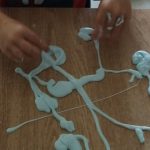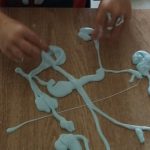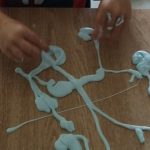We all experience stress and anxiety that can make self-regulation challenging. As adults we have figured out strategies to help us feel more calm and in control of ourselves. Perhaps you listen to music, try a new recipe, get some exercise or chat with a friend. These strategies that use our senses can bring us out of our heads and more focused on the here and now. Our students will retain more of their learning if they are in a good headspace so let’s consider some sensory activities to try.
Slime
I highly recommend creating slime with your students. It is a fantastic learning experience in science and gives students a tactile, gooey substance to stretch, pop, roll, and squeeze. I’ve seen quiet students have confidence to talk to classmates while using slime and I’ve seen students who were screaming calm down completely when slime was introduced.
Brain Breaks
Exercising in the classroom with videos that have visual prompts, music and fun characters can put energy into a class after a longer period of sitting still. No video? No problem! Using a playlist of favourite music combined with body movement is energizing too!
Food Experiences
With a parent volunteer or co-op student it’s rewarding to get some easy recipes like fruit kebabs, veggies and hummus or personal pizzas going. There are so many recipes available to accomodate all kinds of needs. Plus your students will be more likely to try something new in this social situation. Years ago a colleague introduced me to the book Stone Soup and we made soup together. I kept that tradition with all my homeroom classes because students really enjoyed it and it reinforces healthy eating habits.
Crafts
Having materials on hand for students to make creations can be very soothing. The act of creating really gets the mind focussed and calm. I’m a fan of loose parts, a collection of odds and ends like paper towel rolls, scrap paper, plastic lids, bread tags, etc.
Soft Start
Looking for a smoother start to your day? January would be a great time to implement the soft start. Students enter the class and have choice of quiet activities. You may include things like building materials, play dough, drawing, reading, etc. Using a timer can help students to be aware of the transition to your start of day routines.
Invite Animal Visitors
You may have local organizations that sponsor pet visits to the classroom. Animals can bring out the best in humans! I have witnessed examples of empathy from everyone in the class when they are learning about dogs, chicks or even lizards.
I’d love to hear more helpful suggestions from our readers. What works to help your students with self-regulation? Do you have other sensory activities that your students love?
Photo Credit: T. Pfautsch



